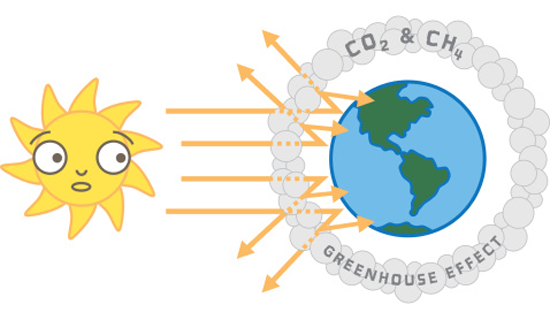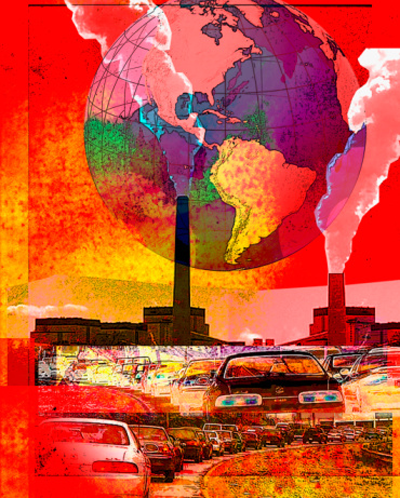Apr 23, 2024
Apr 23, 2024

Imagine during a wintery morning sitting in a car in Sun with all windscreens rolled up. For a while the sunlight is quite soothing, but after a while it begins to hurt. The discomfort mounts so much that you unroll the windows to let some cool air in. Why does it happen, ever thought about it? Well this happens because the Sun’s rays as they enter the car, warm up the air inside. With all the windows rolled up the reflected rays are not able to go out of the car. Instead they keep on heating the air inside the car till you roll down the windows.
 Envelop of the greenhouse gases encircling our atmosphere acts like the windscreen of the car and does not allow the Sun’s rays to go back to go back. Instead keeps on warming up the atmosphere. It is not that that this envelop of greenhouse gases has appeared all of a sudden in our atmosphere. It has been there since the earth came up. In fact some 55 million years ago it was much denser and was responsible for one of the worst ever warm phases of the earth. But fortunately we were not there.
Envelop of the greenhouse gases encircling our atmosphere acts like the windscreen of the car and does not allow the Sun’s rays to go back to go back. Instead keeps on warming up the atmosphere. It is not that that this envelop of greenhouse gases has appeared all of a sudden in our atmosphere. It has been there since the earth came up. In fact some 55 million years ago it was much denser and was responsible for one of the worst ever warm phases of the earth. But fortunately we were not there.
Humans being the most evolved animal are generally away from the nature. Consequently they get affected adversely if there is any change in the temperature. They cannot tolerate excess heat or cold. However they are technologically so advanced that they air-condition their dwellings and work places so as to live in comfort. However, all humans are not so fortunate. A large mass of humanity has to face the vagaries of climate or perish.
In the geologic past there have been periods when the Greenhouse Gas (GHG) Emissions have been of much higher order than present. During one of the worst warming phases of the Earth’s history, known as Paleocene-Eocene Thermal Maxima (PETM) around 55 million years ago temperatures rose high while the Carbon Dioxide content of the atmosphere rose by about 2500 to 6800 giga-tons, led to proliferation of flora and fauna on the planet. Ofcourse we were not there, but most of mammals attained a peak during the period. The Carbon Dioxide content was certainly many times more than the present days in the atmosphere.
The present situation is slightly perilous. Because, in our greed for comforts we are ‘manufacturing’ GHGs at a pace much faster than the natural sources and we have already damaged the Carbon Dioxide sinks, i.e. the Forests. A study shows that during 2007 the emissions of Carbon Dioxide and GHGs were of the order of 2008.67 Tg (Teragram) (1 Tg=1 Million tons) in India.
Usually land-use, land-use change and forestry (LULUCF) sector of the human society emits quite a bit of GHGs. The figures above do not include the emissions from LULUCF sector. It was found that this sector added 1831.65 Tg of Carbon Dioxide equivalents. This study was carried out by S.K. Sharma of Ministry of Environment and Forests, Government of India, New Delhi, along with 12 other researchers from Central Institute of Mining and Fuel, Dhanbad, CRRI, New Delhi, TERI, New Delhi, CII, New Delhi, IARI, NewDelhi, NDRI, Karnal, FSI, Dehradun, ISRO, Hyderabad, IIS, Bangalore, NEERI, Nagpur and NATCOM, New Delhi.
 The study revealed that the energy sector of the country was responsible for 69% of polluting emissions, while the agriculture, industry and the waste sector contributed 19%, 9% and 3% of emissions respectively.
The study revealed that the energy sector of the country was responsible for 69% of polluting emissions, while the agriculture, industry and the waste sector contributed 19%, 9% and 3% of emissions respectively.
The common man in India presumes that there is neither control over emissions nor there is any study about how much is our contribution in the process of adding GHGs in the atmosphere! It is a wrong notion, because such issues are hardly publicized by the media and the research papers remain hidden in the labyrinths of scientific corridors. Actually for the United Nations Framework Convention on Climate Change (UNFCCC) is the agency that monitors all such information strictly to determine the trends of contribution of emissions by the countries party to it.
The annual growth rate of total emissions between 1990 and 1994 was 5.3%. Luckily emissions including the LULUCF sector were reduced to 3.7% for the period 1994 to 2007. In the same period the waste sector emission growth also showed a reduction from 13.2 to 7.3% says the report of S.K. Sharma et.al. But this reduction does not mean that we should become complacent. On the contrary there are areas which need a close monitoring and improved techniques to keep the reductions under control.
Over a period of time we have almost forgotten that vegetation is one of the best sink of Carbon Dioxide, because the green plants use it during photosynthesis. Outcome is the oxygen. In the agriculture sector the rice fields of India are considered to be a major culprit in terms of emissions. Varieties of rice plants that need not remain standing soaked in water over prolonged periods can be developed and propagated. Similarly, the waste disposal of Class I, II and III cities needs to be closely monitored as due to rising population that is one most likely area of increased emissions over a period of time. Rising population means more number of dwellings. Thus the construction industry, particularly iron and cement manufacturing needs are volutionary change to reduce and control emissions. The energy sector cannot be shut down, but efforts to switch over to nuclear energy might give a relief and bring down the emissions considerably.
Unless we are aware of the consequences we will not control the emissions. It is time that the government and the media create awareness in the society about the perils of GHG emissions. If left uncontrolled we may suffocate under our own emissions and die gasping!
Images (c) Gettyimages.com
07-Mar-2012
More by : V. K. Joshi (Bijji)